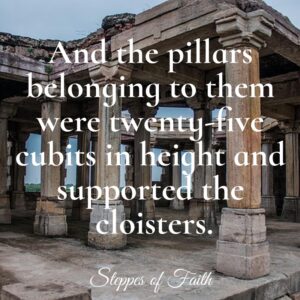
“All the cloisters were double, and the pillars to them belonging were twenty-five cubits (37.5 feet) in height and supported the cloisters.” -Flavius Josephus
Herod’s Temple in Jerusalem was perhaps the pinnacle of all his construction designs. The amount of money and time it took to build it was far more than his other projects, and it was truly a magnificent structure. If you missed how it was made in last week’s Part One of this series, you can find it right here.
Here in Part Two, we’ll go inside the Temple as a Jewish pilgrim would have done during a typical Yom Kippur festival. We’ll walk through the grand entrances and make our way through the crowds until we reach the courts to worship up until the Holy of Holies. And, we’ll discover some of the areas of the Temple where Jesus once walked and ministered along the way.
Are you ready? Let’s go!
Entering the Temple
The Temple was an enormous and extravagant piece of architecture. Herod’s renovation of Solomon’s Temple included many of the original features. His main changes were to the Gentile Court and surrounding infrastructure. More on that in a minute.
Let’s enter the plaza and take a walk until we reach the Holy of Holies. But first, you must bathe before you decide which gate you’re going to enter through.
It was a common custom and requirement that everyone must immerse him- or herself in a ritual bath before entering the Temple. One of these bathing pools was near the Sheep Gate and is where Jesus healed a lame man who couldn’t get into the pool because he was constantly being pushed back (John 5:2-8).
So, go ahead! Wade into the cool water.
Now that you are ceremonially clean, you have to decide whether to head toward either the Golden Gate to the east, the Gate of Coponius to the west (which was also the main gate), or the southern Huldah Gates to enter the plaza.
If you choose to enter through the Golden Gate as Jesus did, you will cross over an enormous bridge so you can enter near the Temple proper where the courts and the Holy of Holies are located.
The bridge was the width of a four-lane highway and had double arches made of stones collectively weighing over 1,000 tons. The only way the 10,000 laborers could build the bridge was by creating a hill, building the bridge on top of it, and then removing the hill. That’s quite a bit of engineering.
A smaller bridge on the west side crossed over the main road and markets and into the plaza through the Gate of Coponius near the money exchange room. You might first enter the Temple this way since it was important to exchange your Roman coins for Hebrew ones. No coins with Caesar’s image on it was acceptable in the Temple offering.
You could also get to the exchange room from the south side of the plaza. The room is located in a building on the royal portico just across from the Kidron Valley. Coming from this direction, the only way to get to the exchange room was by climbing an enormous flight of stairs through underground passages underneath the platform that led to two Huldah Gates.
The Huldah Gates are just fine, but let’s explore the eastern entrance at the Golden Gate first.
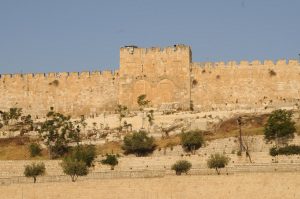
The Royal Portico
If you decided to cross the eastern bridge, you would enter through the Golden Gate at Solomon’s Porch (like Jesus did).
Solomon’s Porch is where Jesus was accidentally left behind by Mary and Joseph as He questioned the rabbis when He was twelve years old (Luke 2:49). Also, on the east side by Solomon’s Porch was the high corner where the pinnacle of the Temple is located. The pinnacle is mentioned in the story of Satan’s temptation of Jesus before He began His ministry (Matthew 4:5).
From Solomon’s Porch, you cross through the royal portico before entering the Court of the Gentiles. The portico was constructed with enormous double colonnades. Renowned first-century historian Flavius Josephus describes it this way:
“All the cloisters were double, and the pillars to them belonging were twenty-five cubits (37.5 feet) in height and supported the cloisters. These pillars were of one entire stone each of them, and that stone was white marble; and the roofs were adorned with cedar, curiously graven. The natural magnificence, and excellent polish and the harmony of the joints in these cloisters afforded a prospect that was very remarkable; nor was it on the outside adorned with any work of the painter or engraver. The cloisters (of the outermost court) were in breadth thirty cubits (40 feet), while the entire compass of it was by measure six furlongs (440 feet), including the tower of Antonia; those entire courts that were exposed to the air were laid with stones of all sorts” (Jewish War 5.5.2; my additions).
According to this description, the stones were made of highly polished marble that shone so brightly that no painter or engraver was necessary to beautify it. The roof was made of cedar, a very expensive wood, and the courts were made with “stones of all sorts.
Now, let’s explore the southern entrance through the Huldah Gates.
The Gentile Court
If you enter through the southern Huldah, or “mole,” Gates, you walk through a very ornate underground tunnel lit by candles that ramped up and out onto the plaza. As you go along, you begin to hear the Levite priests singing ritual hymns and playing instruments on the plaza, and you hear the buzz of the crowd as they gather for the festival.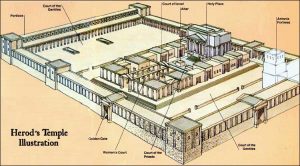
Once you emerge out of the tunnel, you find yourself in the Court of Gentiles. This is the outer court that was open to the public regardless of faith. The people often gathered in the porticos that outlined the court to chat, listen to the music, or visit with the rabbis. They would also exchange their money at the Temple “bank” here over by the royal portico. This area is where Jesus disrupted the moneychangers and turned over the tables on two separate occasions (John 2:13-16; Matthew 21:12-13).
The main Gate of Coponius on the western side also leads to the Court of Gentiles after you cross over its entry bridge.
But since you went through the Huldah Gates, you only need to walk a little way to the right and go around a corner where you find yourself in front of the Beautiful Gate. This gate was the entrance to the Woman’s Court and is where the women gathered to worship. It was also where the poor boxes were located and where Jesus witnessed the poor widow casting her last two pennies in Luke 21:1-4.
The Woman’s Court
No Gentiles were allowed inside the Woman’s Court or anywhere past this point. To make sure everyone knew this, a four and one-half foot tall stone partition containing a placard warning Gentiles to “stay out” blocked the entrance. The placard was written in both Greek and Latin to make everyone could read it.
You could have also entered the Woman’s Court through the Chel, which is only fifteen steps away from the court. The Chel is what we might call a shortcut to the Temple.
The Chel is a fifteen-foot wide terraced area located against the enclosing wall of the colonnade surrounding the royal portico and the Gentile Court. It’s just off the main steps leading to the Huldah Gates on the south side of the plaza.
If you weren’t interested in what was going on in the Gentile Court, all you had to do was ascend the seven-foot staircase to your right as you came up the main steps. Once on the terrace, you would have seen thirteen gaps in a fenced enclosure, all leading to the Beautiful Gate and the Woman’s Court. Seats were placed on the Chel, and the women often liked to gather there to watch the festive crowd.
No idolaters or those “defiled by the dead” were permitted on the Chel. It seems only those who were Jewish could go onto it.
Whether you entered the plaza through the Chel or by wandering through the Gentile Court, you have made it to the Woman’s Court, which is the entrance to the Temple proper.
Let’s go inside.
The Four Chambers
As you enter the Woman’s Court, you look around and see four 60×60 foot open-air chambers in the four corners of the court. You notice that each chamber seems to have a separate purpose, and you’re right.
There is the Chamber of Oils, the Chamber of Nazarites, the Chamber of Lepers, and the Chamber of Wood.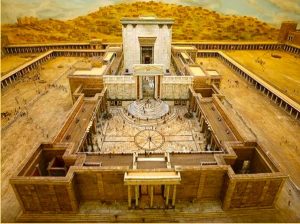
Chamber of Oils. The Chamber of Oils, or Oil of Yah, is in the southwest corner to your back right. It contains vaults where certain oils and wine are preserved for drink offerings.
Chamber of Nazarites. In the opposite (southeast) back corner, you see Nazarites bringing their sacrificial offerings and preparing to shave their heads inside the Chamber of Nazarites. Nazarites were people who took a vow to consecrate themselves to God by refraining from cutting their hair, drinking wine (although other types of alcohol may have been permissible), and never to touch a corpse or grave, even of family members or else they would be ritually unclean.
Nazarites traditionally bring three sacrificial animal offerings to the chamber: lamb as a burnt offering, a ewe as a sin offering, and a ram as a peace offering. They also bring a basket of unleavened bread and grain and drink offerings to accompany the peace offering. They cook the sacrificial animals by themselves inside the chamber instead of allowing a Temple priest to do it. After they finish cooking, they cut their hair, and the clippings are placed in the fire along with the peace offering.
Chamber of Lepers. To your front right, you see lepers entering this chamber to purify themselves before presenting themselves to the priests at the Nicanor Gate (more on that in a moment).
Chamber of Wood. Finally, continuing around the court to your front left, you see the Chamber of Wood. This chamber is where priests who are found to be unfit for holy practices due to body blemishes conduct basic Temple tasks. One such task is to separate worm-infested wood from suitable wood that will be used at the altar for burnt offerings.
In between the chambers, you see open portals. These are the exits leading down to the street level lower gates in case you need to leave quickly after worship. You can also exit back out through the Beautiful Gate or through the Chel.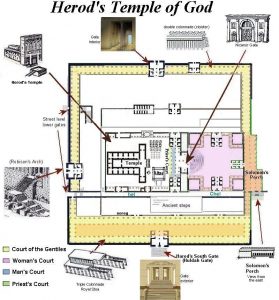
The Man’s Court
If you’re a man, you may pass through the Woman’s Court to ascend a large set of semicircular steps leading to the Nicanor Gate.
While the other Temple gates are plated in silver and set in gold, the Nicanor Gate is plated with magnificent Corinthian bronze. Rumor has it that miracles occurred at this gate, which is why it was never covered with any gold or silver.
If you’re celebrating the Feast of Tabernacles in the fall, you would see priests at the Nicanor Gate singing the fifteen “Psalms of Degrees” taken from Psalm 120-134. You also usually see lepers and women (after childbirth and menstruation) coming to be purified by the priests. It’s at the gate where everything that is ordered to be done before the Lord takes place.
To Christians, it’s notable that the Nicanor Gate is where Mary and Joseph presented Jesus to the priests eight days after His birth (Luke 2:22-24), and where they encountered Simeon (v25) and the prophetess Anna (v36-38).
The Man’s Court (also called the Court of Israel or Court of Israelites) is just past the gate and through a small vestibule. You’ll notice that the Court is significantly smaller than the Women’ s Court, perhaps because fewer people can assemble there. There is also nothing remarkable about the room aside from its marble walls. It is simply a gathering place for the men to socialize and worship.
The Brazen Sea
Beyond the Man’s Court is the Priest’s Court where only priests are permitted to enter. Since Jesus wasn’t a Temple priest, He never entered this area.
Let’s pretend you’re one of the 60 priests of the Temple.
As you walk into the Priest’s Court, you immediately see three slaughter tables for the sacrifices to your right. You also see an altar for burnt offerings in the center of the court plus lampstands, pouring vessels, and incense burners all made of pure gold. You also couldn’t help but notice the Brazen Sea in the southeast corner to your left.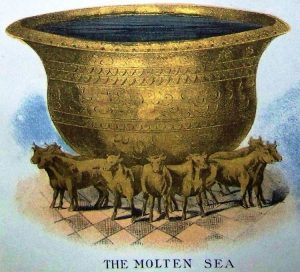
The Brazen Sea was an exceptionally enormous basin made of bronze that had the capacity to hold about 18,000 gallons of water (you read that right). It provided the priests with a place to wash themselves as well as the sacrificial animals, and it held its own water source that was necessary to keep it flowing like a fountain.
Solomon had the basin built according to the Lord’s design that was first given to his father, King David.
“And he made the Sea of cast bronze, ten cubits [15 feet] from one brim to the other; it was completely round. Its height was five cubits [7.5 feet], and a line of thirty cubits [45 feet] measured its circumference. Below its brim were ornamental buds encircling it all around, ten to a cubit [every 1.5 feet], all the way around the Sea. The ornamental buds were cast in two rows. It stood on twelve oxen: three looking [in every direction], and all their back parts were pointed inward. It was a hand-breadth thick, and its brim was shaped like the brim of a cup, like a lily blossom. It contained three thousand baths [18,000 gallons].” 2 Chronicles 4:2-5; 1 Kings 7:23-26 (my additions)
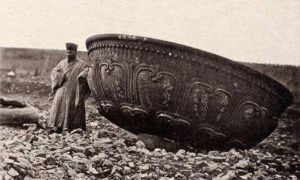
(The Chinese also made a bowl similar to the Brazen Sea for their own religious practices. The above photo perhaps shows just how big the Jewish Brazen Sea might have been.)
As the priests busily prepare the sacrificed animals at the Brazen Sea, slaughter them at the tables, and burn them on the altar, you look over and notice the High Priest preparing to enter the Holy of Holies.
The official offering to the Lord is about to begin.
Next week in Part Three, we’ll explore the Holy of Holies and what it was like to be the High Priest on Yom Kippur. We’ll walk through the Holy Place and the inner sanctuary, the Holy of Holies, and discover what it was like to be the High Priest on such a day and what our duties were amidst this section of the Temple.
Hope to see you here again, next week!
So fascinating! Thank you for putting this together.
I’m a history nut, so it was a lot of fun to do. I learned so much. Thanks for stopping by. God bless!